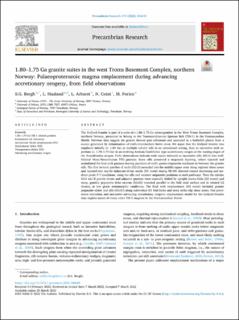| dc.contributor.author | Bergh, Steffen Gunnar | |
| dc.contributor.author | Haaland, Linda Cecilia | |
| dc.contributor.author | Arbaret, L. | |
| dc.contributor.author | Coint, Nolwenn | |
| dc.contributor.author | Forien, Melanie | |
| dc.date.accessioned | 2022-04-26T08:13:11Z | |
| dc.date.available | 2022-04-26T08:13:11Z | |
| dc.date.created | 2022-04-09T16:27:02Z | |
| dc.date.issued | 2022 | |
| dc.identifier.citation | Precambrian Research. 2022, 374 (106640), . | en_US |
| dc.identifier.issn | 0301-9268 | |
| dc.identifier.uri | https://hdl.handle.net/11250/2992720 | |
| dc.description.abstract | The Ersfjord Granite is part of a suite of c.1.80–1.75 Ga syeno-granites in the West Troms Basement Complex, northern Norway, presumed to belong to the Transscandinavian Igneous Belt (TIB-1) in the Fennoscandian Shield. Previous data suggest the granite formed post-collisional and ascended as a batholith pluton from a source generated by delamination of mafic-intermediate lower crust. We argue that the Ersfjord Granite was emplaced initially (c. 1.80 Ga) as multiple tabular sills in an extensional setting, then as successive melt injections (c. 1.78–1.75 Ga) in an evolving Andean/Cordilleran type accretionary orogen at the waning stages of the Svecofennian orogen. Field observations indicate melt ascent initiated as successive sills (EG-I) into well-foliated Meso/Neoarchaean TTG gneisses. Some sills preserved a magmatic layering, others injected and assimilated the host rock gneisses leaving pendants of mafic gneiss/migmatite residuum in between the granite sills. The first tectonic patches of melts (EG-II) ascended into the middle/upper crust along regional shear zones and injected into ductile imbricate thrust stacks (D1 event) during NE-SW directed crustal shortening and medium grade P-T conditions, using the sills and ancestor migmatite pendants as melt pathways. Then the tabular EG-I and II granite sheets and adjacent gneisses were coaxially folded by upright macro-folds (D2 event) and steep, granitic pegmatite dyke swarms (EG-III) intruded parallel to the fold axial surface and in related D2 thrusts, at low grade metamorphic conditions. The final melt emplacement (D3 event) included granite pegmatite dykes and sills (EG-IV) along subvertical D3 fold limbs and steep strike-slip shear zones. Our provisional extension, and successive advancing accretionary orogenic emplacement model for the Ersfjord Granite may explain ascent of many other TIB-1 magmas in the Fennoscandian Shield | en_US |
| dc.language.iso | eng | en_US |
| dc.publisher | Elsevier | en_US |
| dc.rights | Navngivelse 4.0 Internasjonal | * |
| dc.rights.uri | http://creativecommons.org/licenses/by/4.0/deed.no | * |
| dc.title | 1.80–1.75 Ga granite suites in the west Troms Basement Complex, northern Norway: Palaeoproterozoic magma emplacement during advancing accretionary orogeny, from field observations | en_US |
| dc.title.alternative | 1.80–1.75 Ga granite suites in the west Troms Basement Complex, northern Norway: Palaeoproterozoic magma emplacement during advancing accretionary orogeny, from field observations | en_US |
| dc.type | Peer reviewed | en_US |
| dc.type | Journal article | en_US |
| dc.description.version | publishedVersion | en_US |
| dc.source.pagenumber | 20 | en_US |
| dc.source.volume | 374 | en_US |
| dc.source.journal | Precambrian Research | en_US |
| dc.source.issue | 106640 | en_US |
| dc.identifier.doi | 10.1016/j.precamres.2022.106640 | |
| dc.identifier.cristin | 2016399 | |
| cristin.ispublished | true | |
| cristin.fulltext | original | |
| cristin.qualitycode | 2 | |

